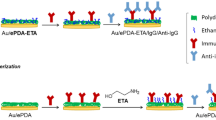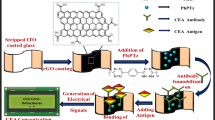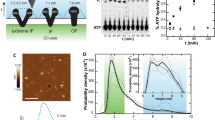Abstract
Polymer field-effect transistors (PFETs) are among the most fascinating electronic devices because of their attractive properties, such as durability, environmental friendliness, and solution processability. To date, PFETs have been employed for the development of flexible displays, radio-frequency identification tags, flexible non-volatile memories, among others. Moreover, due to the above advantages, PFETs can be applied to disposable on-site analytical devices. In that regard, we have developed extended-gate type PFETs with molecular recognition biomaterials for protein sensing in aqueous media. The fabricated PFETs were used to successfully detect glycoproteins (immunoglobulin A, immunoglobulin G, and chromogranin A) without any complicated labeling processes. Since our proposed immunoassay, which is performed on the basis of extended-gate type PFETs, is rapid and easy-to-use, PFET will be an attractive platform for on-site monitoring devices in healthcare applications in the near future.
Similar content being viewed by others
Log in or create a free account to read this content
Gain free access to this article, as well as selected content from this journal and more on nature.com
or
References
Clark LC Jr, Lyons C. Electrode systems for continuous monitoring in cardiovascular surgery. Ann NY Acad Sci. 1962;102:29–45.
Updike SJ, Hicks GP. The enzyme electrode. Nature. 1967;214:986–8.
Grieshaber D, MacKenzie R, Vörös J, Reimhult E. Electrochemical Biosensors - Sensor Principles and Architectures. Sensors. 2008;8:1400–58.
Crosson C, Rossi C. Quartz crystal microbalance immunosensor for the quantification of immunoglobulin G in bovine milk. Biosens Bioelectron. 2013;42:453–9.
Islam N, Shen F, Gurgel PV, Rojas OJ, Carbonell RG. Dynamic and equilibrium performance of sensors based on short peptide ligands for affinity adsorption of human IgG using surface plasmon resonance. Biosens Bioelectron. 2014;58:380–7.
Cheng S, Hotani K, Hideshima S, Kuroiwa S, Nakanishi T, Hashimoto M, et al. Field effect transistor biosensor using antigen binding fragment for detecting tumor marker in human serum. Materials. 2014;7:2490–500.
Sirringhaus H. 25th Anniversary article: organic field-effect transistors: the path beyond amorphous silicon. Adv Mater. 2014;26:1319–35.
Gelinck G, Heremans P, Nomoto K, Anthopoulos TD. Organic transistors in optical displays and microelectronic applications. Adv Mater. 2010;22:3778–98.
Subramanian V, Fréchet JMJ, Chang PC, Huang DC, Lee JB, Molesa SE, et al. Progress toward development of all-printed RFID tags: materials, processes, and devices. Proc IEEE. 2005;93:1330–8.
Heremans P, Gelinck GH, Müller R, Baeg K-J, Kim D-Y, Noh Y-Y. Polymer and organic nonvolatile memory devices. Chem Mater. 2011;23:341–58.
Bergveld P. Thirty years of ISFETOLOGY: what happened in the past 30 years and what may happen in the next 30 years. Sens Actuators B. 2003;88:1–20.
Stoliar P, Bystrenova E, Quiroga SD, Annibale P, Facchini M, Spijkman M, et al. DNA adsorption measured with ultra-thin film organic field effect transistors. Bionsens Bioelectron. 2009;24:2935–8.
Kumaki D, Umeda T, Tokito S. Influence of H2O and O2 on threshold voltage shift in organic thin-film transistors: deprotonation of SiOH on SiO2 gate-insulator surface. Appl Phys Lett. 2008;92:093309.
Sekine T, Fukuda K, Kumaki D, Tokito S. The effect of mechanical strain on contact resistance in flexible printed organic thin-film transistors. Flex Print Electron. 2016;1:035005.
Minamiki T, Minami T, Kurita R, Niwa O, Wakida S, Fukuda K, et al. Accurate and reproducible detection of proteins in water using an extended-gate type organic transistor biosensor. Appl Phys Lett. 2014;104:243703.
Klauk H, Zschieschang U, Pflaum J, Halik M. Ultralow-power organic complementary circuits. Nature. 2007;445:745–8.
McCulloch I, Heeney M, Bailey C, Genevicius K, MacDonald I, Shkunov M, et al. Liquid-crystalline semiconducting polymers with high charge-carrier mobility. Nat Mater. 2006;5:328–33.
Umeda T, Kumaki D, Tokito S. Surface-energy-dependent field-effect mobilities up to 1 cm2/V s for polymer thin-film transistor. J Appl Phys. 2009;105:024516.
Horowitz G. Organic field-effect transistors. Adv Mater. 1998;10:365–77.
Sakata T, Fukuda R. Simultaneous biosensing with quartz crystal microbalance with a dissipation coupled-gate semiconductor device. Anal Chem. 2013;85:5796–800.
Stayton PS, Freitag S, Klumb LA, Chilkoti A, Chu V, Penzotti JE, et al. Streptavidin-biotin binding energetics. Biomol Eng. 1999;16:39–44.
Kay RA, Wood KJ, Bernstein RM, Holt PJ, Pumphrey RS. An IgG subclass imbalance in connective tissue disease. Ann Rheum Dis. 1988;47:536–41.
Gocki J, Bartuzi Z. Role of immunoglobulin G antibodies in diagnosis of food allergy. Post Dermatol Alergol. 2016;33:253–6.
De Boer B, Hadipour A, Mandoc MM, van Woudenbergh T, Blom PWM. Tuning of metal work functions with self-assembled monolayers. Adv Mater. 2005;17:621–5.
Chen CP, Ganguly A, Lu CY, Chen TY, Kuo CC, Chen RS, et al. Ultrasensitive in situ label-free DNA detection using a GaN nanowire-based extended-gate field-effect-transistor sensor. Anal Chem. 2011;83:1938–43.
Miller JN, Miller JC. Statistics and Chemometrics for Analytical Chemistry. 6th edn. Harlow, UK: Pearson; 2010.
Minamiki T, Minami T, Kurita R, Niwa O, Wakida S, Fukuda K, et al. A label-free immunosensor for IgG based on an extended-gate type organic field effect transistor. Materials. 2014;7:6843–52.
Fagarasan S, Honjo T. Intestinal IgA synthesis: regulation of front-line body defences. Nat Rev Immunol. 2003;3:63–72.
Nagai H, Narita Y, Ohtaki M, Saito K, Wakida S. A single-bead analysis on a disk-shaped microfluidic device using an antigen-immobilized bead. Anal Sci. 2007;23:975–9.
Shirtcliff EA, Granger DA, Schwartz E, Curran MJ. Use of salivary biomarkers in biobehavioral research: cotton-based sample collection methods can interfere with salivary immunoassay results. Psychoneuroendocrinology. 2001;26:165–73.
Minamiki T, Minami T, Sasaki Y, Kurita R, Niwa O, Wakida S, et al. An organic field-effect transistor with an extended-gate electrode capable of detecting human immunoglobulin A. Anal Sci. 2015;31:725–8.
Zakowski JJ, Bruns DE. Biochemistry of human alpha amylase isoenzymes. Crit Rev Clin Lab Sci. 1985;21:283–322.
Nater UM, Rohleder N, Gaab J, Berger S, Jud A, Kirschbaum C, et al. Human salivary alpha-amylase reactivity in a psychosocial stress paradigm. Int J Psychophysiol. 2005;55:333–42.
Glimvall P, Wickström C, Jansson H. Elevated levels of salivary lactoferrin, a marker for chronic periodontitis? J Periodontal Res. 2012;47:655–60.
Thoma EL, Jefferson MM, Joyner RE, Cook GS, King CC. Leukocyte myeloperoxidase and salivary lactoperoxidase: identification and quantitation in human mixed saliva. J Dent Res. 1994;73:544–55.
Fox JG, Perkins S, Yan L, Shen Z, Attardo L, Pappo J. Local immune response in Helicobacter pylori-infected cats and identification of H. pylori in saliva, gastric fluid and faeces. Immunology. 1996;88:400–6.
Flies AS, Grant CK, Mansfield LS, Smith EJ, Weldele ML, Holekamp KE. Development of a hyena immunology toolbox. Vet Immunol Immunopathol. 2012;145:110–9.
Sakata T, Matsuse Y. In situ electrical monitoring of cancer cells invading vascular endothelial cells with semiconductor-based biosensor. Genes Cells. 2017;22:203–9.
Hegde M, Devadiga D, Shetty C, Shetty A. Correlation between dental caries and salivary immunoglobulin in adult Indian population: an in vivo study. J Res Dent. 2013;1:22–5.
Smith DJ, Taubman MA, Ebersole JL. Ontogeny and senescence of salivary immunity. J Dent Res. 1987;66:451–6.
D’amico MA, Ghinassi B, Izzicupo P, Manzoli L, Di Baldassarre A. Biological function and clinical relevance of chromogranin A and derived peptides. Endocr Connect. 2014;3:R45–R54.
Portela-Gomes GM, Gayen JR, Grimelius L, Stridsberg M, Mahata SK. The importance of chromogranin A in the development and function of endocrine pancreas. Regul Pept. 2008;151:19–25.
Conlon JM. Granin-derived peptides as diagnostic and prognostic markers for endocrine tumors. Regul Pept. 2010;165:5–11.
Biomarkers Definition Working Group. Biomarkers and surrogate endpoints: preferred definitions and conceptual framework. Clin Pharmacol Ther. 2001;69:89–95.
O’Toole D, Grossman A, Gross D, Delle-Fave G, Barkmanova J, O’Connor J, et al. ENETS Consensus Guidelines for the Standards of Care in Neuroendocrine Tumors: Biochemical Markers. Neuroendocrinology. 2009;90:194–202.
Bartolomucci A, Pasinetti GM, Salton SRJ. Granins as disease-biomarkers: translational potential for psychiatric and neurological disorders. Neuroscience. 2010;170:289–97.
Rai B, Kaur J. Salivary stress markers and psychological stress in simulated microgravity: 21 days in 6o head-down tilt. J Oral Sci. 2011;53:103–7.
Katsuura S, Kamezaki Y, Yamagishi N, Kuwano Y, Nishida K, Masuda K, et al. Circulating vascular endothelial growth factor is independently and negatively associated with trait anxiety and depressive mood in healthy Japanese university students. Int J Psychophysiol. 2011;81:38–43.
Wang CW, Pan CY, Wu HC, Shih PY, Tsai CC, Liao KT, et al. In situ detection of chromogranin A released from living neurons with a single-walled carbon-nanotube field-effect transistor. Small. 2007;3:1350–5.
Minamiki T, Minami T, Sasaki Y, Wakida S, Kurita R, Niwa O, et al. Label-free detection of human glycoprotein (CgA) using an extended-gated organic transistor-based immunosensor. Sensors. 2016;16:2033.
Wilson BS, Lloyd RV. Detection of chromogranin in neuroendocrine cells with a monoclonal antibody. Am J Pathol. 1984;115:458–68.
Nishikawa Y, Jun L, Futai Y, Yanaihara N, Iguchi K, Mochizuki T, et al. Region-specific radioimmunoassay for human chromogranin A. Biomed Res. 1998;19:245–51.
Fukuda K, Minamiki T, Minami T, Watanabe M, Fukuda T, Kumaki D, et al. Printed organic transistors with uniform electrical performance and their application to amplifiers in biosensors. Adv Electron Mater. 2015;1:1400052.
Stridsberg M, Eriksson B, Öberg K, Janson ET. A comparison between three commercial kits for chromogranin A measurements. J Endocrinol. 2003;177:337–41.
Yeung CL, Iqbal P, Allan M, Lashkor M, Preece JA, Mendes PM. Tuning specific biomolecular interactions using electro-switchable oligopeptide surfaces. Adv Funct Mater. 2010;20:2657–63.
Minamiki T, Minami T, Koutnik P, Anzenbacher P Jr, Tokito S. Antibody- and label-free phosphoprotein sensor device based on an organic transistor. Anal Chem. 2016;88:1092–5.
Minamiki T, Sasaki Y, Tokito S, Minami T. Label-free direct electrical detection of a histidine-rich protein with sub-femtomolar sensitivity using an organic field-effect transistor. ChemistryOpen. 2017;6:472–5.
Acknowledgements
We gratefully acknowledge financial support from the Towa Foundation for Food Science and Research, the Kanamori Foundation, the Descente and Ishimoto Memorial Foundation for the Promotion of Sports Science, Tateishi Science and Technology Foundation, Society for Research on Umami Taste, and Japan Society for the Promotion of Science (JSPS, Grant-in-Aid for Scientific Research, Nos. 16J08092, 17H04882, 17K14489, and 18J21190). We also thank Prof. S. Tokito (Yamagata University), Prof. O. Niwa (Saitama Institute of Technology), Dr. R. Kurita and Dr. S. Wakida (National Institute of Advanced Industrial Science and Technology) for their technical support and valuable feedback. YS is also grateful to the JSPS Research Fellowships for Young Scientists.
Author information
Authors and Affiliations
Corresponding author
Ethics declarations
Conflict of interest
The authors declare that they have no conflict of interest.
Rights and permissions
About this article
Cite this article
Minamiki, T., Sasaki, Y., Su, S. et al. Development of polymer field-effect transistor-based immunoassays. Polym J 51, 1–9 (2019). https://doi.org/10.1038/s41428-018-0112-0
Received:
Revised:
Accepted:
Published:
Issue date:
DOI: https://doi.org/10.1038/s41428-018-0112-0
This article is cited by
-
Chemical sensing based on water-gated polythiophene thin-film transistors
Polymer Journal (2021)
-
Structural effect of fluorophore on phenylboronic acid fluorophore/cyclodextrin complex for selective glucose recognition
Frontiers of Chemical Science and Engineering (2020)



